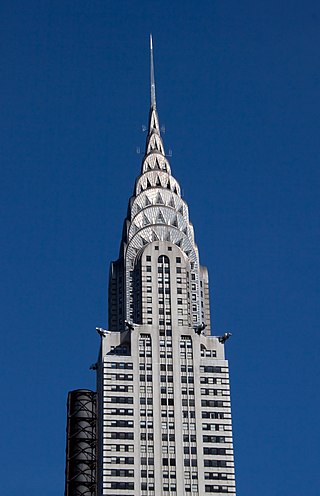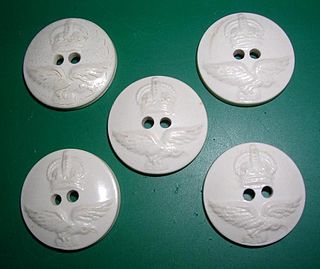
Amber is fossilized tree resin. Examples of it have been appreciated for its color and natural beauty since the Neolithic times, and worked as a gemstone since antiquity. Amber is used in jewelry and as a healing agent in folk medicine.

Art Deco, short for the French Arts décoratifs, is a style of visual arts, architecture, and product design, that first appeared in Paris in the 1910s, and flourished in the United States and Europe during the 1920s to early 1930s. Through styling and design of the exterior and interior of anything from large structures to small objects, including how people look, Art Deco has influenced bridges, buildings, ships, ocean liners, trains, cars, trucks, buses, furniture, and everyday objects including radios and vacuum cleaners.

Bakelite, formally polyoxybenzylmethyleneglycolanhydride, is a thermosetting phenol formaldehyde resin, formed from a condensation reaction of phenol with formaldehyde. The first plastic made from synthetic components, it was developed by Leo Baekeland in Yonkers, New York, in 1907, and patented on December 7, 1909.

Costume or fashion jewelry includes a range of decorative items worn for personal adornment that are manufactured as less expensive ornamentation to complement a particular fashionable outfit or garment as opposed to "real" (fine) jewelry, which is more costly and which may be regarded primarily as collectibles, keepsakes, or investments. From the outset, costume jewelry — also known as fashion jewelry — paralleled the styles of its more precious fine counterparts.

Formica Laminate is a laminated composite material invented at the Westinghouse Electric Corporation in the United States in 1912. Originally used to replace mica in electrical applications, it has since been manufactured for multiple applications. It has been produced by Formica Group manufacturing sites across the globe since. Formica Group are best known for the company's classic product: a heat-resistant, wipe-clean laminate of paper with melamine resin.

A marble is a small spherical object often made from glass, clay, steel, plastic, or agate. They vary in size, and most commonly are about 13 mm in diameter. These toys can be used for a variety of games called marbles, as well being placed in marble runs or races, or created as a form of art. They are often collected, both for nostalgia and for their aesthetic colors.

Fiesta is a line of ceramic glazed dinnerware manufactured and marketed by the Fiesta Tableware Company of Newell, West Virginia since its introduction in 1936, with a hiatus from 1973 to 1985. Fiesta is noted for its Art Deco styling and its range of often bold, solid colors.

Polymer clay is a type of hardenable modeling clay based on the polymer polyvinyl chloride (PVC). It typically contains no clay minerals, but like mineral clay a liquid is added to dry particles until it achieves gel-like working properties. Similarly, the part is put into an oven to harden, hence its colloquial designation as clay. Polymer clay is generally used for making arts and craft items, and is also used in commercial applications to make decorative parts. Art made from polymer clay can now be found in major museums.

Uranium glass is glass which has had uranium, usually in oxide diuranate form, added to a glass mix before melting for colouration. The proportion usually varies from trace levels to about 2% uranium by weight, although some 20th-century pieces were made with up to 25% uranium.

An antique radio is a radio receiving set that is collectible because of its age and rarity.

A table radio is a small, self-contained radio receiver used as an entertainment device. Most such receivers are limited to radio functions, though some have compact disc or audio cassette players and clock radio functions built in; some models also include shortwave or satellite radio functionality.

Galalith is a synthetic plastic material manufactured by the interaction of casein and formaldehyde. The commercial name is derived from the Ancient Greek words gala and lithos. It is odourless, insoluble in water, biodegradable, non-allergenic, antistatic and virtually nonflammable. It was produced under other names such as aladdinite, Casolith and lactoloid.

Faturan, in Middle Eastern beadwork, is a material used to make beads, notably in the making of komboloi and misbaha.

The A.H. Heisey Company was formed in Newark, Ohio, in 1895 by A.H. Heisey. The factory provided fine quality glass tableware and decorative glass figurines. Both pressed and blown glassware were made in a wide variety of patterns and colors. The company also made glass automobile headlights and Holophane Glassware lighting fixtures. The company was operated by Heisey and his sons until 1957, when the factory closed.

In the field of cultural studies, glamour, or glamor, is the impression of attraction or fascination that a particularly luxurious or elegant appearance creates, an impression which intensifies reality. Usually, a person, event, location, technology, or product such as a piece of clothing can be glamorous or add glamour. "Glamour" originally referred to a magic spell, an illusion said to be cast by witches.

Léa Stein is a French artist and accessories maker, known for her compressed plastic buttons, brooches and bracelets. She is often hailed as "the most notable and innovative designer of plastic jewelry of the 20th century".
The conservation and restoration of ivory objects is the process of maintaining and preserving objects that are ivory or include ivory material. Conservation and restoration are aimed at preserving the ivory material and physical form along with the objects condition and treatment documentation. Activities dedicated to the preservation of ivory objects include preventing agents of deterioration that specifically connect with ivory as a material, preventative conservation, and treatment of ivory objects. Conservators, curators, collections managers, and other museum personnel are in charge of taking the necessary measurements to ensure that ivory objects are well maintained and will make the decision for any conservation and restoration of the objects.

Huichol art broadly groups the most traditional and most recent innovations in the folk art and handcrafts produced by the Huichol people, who live in the states of Jalisco, Durango, Zacatecas and Nayarit in Mexico. The unifying factor of the work is the colorful decoration using symbols and designs which date back centuries. The most common and commercially successful products are "yarn paintings" and objects decorated with small commercially produced beads. Yarn paintings consist of commercial yarn pressed into boards coated with wax and resin and are derived from a ceremonial tablet called a nierika. The Huichol have a long history of beading, making the beads from clay, shells, corals, seeds and more and using them to make jewelry and to decorate bowls and other items. The "modern" beadwork usually consists of masks and wood sculptures covered in small, brightly colored commercial beads fastened with wax and resin.

Acrylic embedment is a process of encapsulating various objects into lucite. The process is used for preserving specimens, encapsulating electronics, and making decorative items such as trophies and jewelry.
Baker, Lillian. Plastic Jewelry of the Twentieth Century: Identification & Value Guide, 2003, Collector Books



















